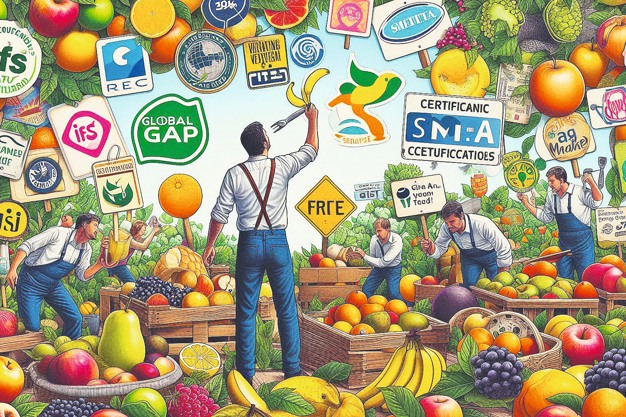Food packaging is overflowing with labels and logos, many of which refer to certifications and quality marks. For growers and traders, these have become an essential requirement to do business with retailers—a sector that accounts for an estimated 90% of vegetable and fruit sales for home consumption in the Netherlands. While certifications ensure good practices, they also serve as a marketing tool—one that comes at a cost. Let’s dive into the world of GlobalG.A.P., Naturland, IFS, and their counterparts.

A jungle of certifications
Certifications come in all shapes and sizes. Some relate to cultivation methods (whether a tomato is organically grown, for instance, is indicated by a label), while others focus on food safety, covering aspects such as pesticide residues, heavy metals, nitrates, or microbiological contamination. Market-recognized standards also help demonstrate compliance with environmental management, worker welfare, and fair pricing requirements.
Some protocols are highly specific—Fairtrade, for example, focuses on fair trade conditions for growers in developing countries—while others are broader in scope. GlobalG.A.P., for instance, ensures good agricultural practices related to food safety, environmental management, and worker welfare. Given the sheer number of certifications, overlaps are inevitable. “Sustainably Grown is comparable to Rainforest Alliance,” notes a Peruvian grower. And what’s the difference between LEAF and Naturland?
It’s easy to get lost in this “jungle of certifications” because there are just so many trees. One customer may demand accreditation A, while another insists on standard B. Preferences often vary by country—Sustainably Grown, for instance, is mainly valued in the United States. However, some constants remain: anyone looking to sell fresh produce on the international market can hardly bypass GlobalG.A.P.
The cost factor
Obtaining and maintaining a certification is not free. A recognized certification body—responsible for conducting audits and issuing the certificate—charges periodic fees (usually annually), along with registration and licensing fees from the certification organization itself. Moreover, meeting the required standards often demands investments in infrastructure and adjustments to business operations.
These sometimes hefty costs can strain business profitability or even block market opportunities—precisely the opposite of what certifications are intended to achieve. This is a frequent complaint among small-scale fruit and vegetable companies in developing countries hoping to export to Europe. In contrast, access to Asian and American markets appears to involve fewer social and environmental hurdles. This raises the question: should European standards be imposed one-to-one on agribusinesses in economically weaker regions? Could Europe risk losing suppliers to China and the U.S., who are even often willing to pay a higher price for the produce? That said, Europe might also gain an advantage, especially with Trump stirring up trade wars through import tariffs, including those affecting Mexico.
The raised finger
Does imposing stringent standards, which are difficult and expensive to meet, risk turning the goal of improving smallholder farmers’ living conditions into an empty promise? If these requirements were matched by sufficiently high purchase prices, foreign growers and exporters might have fewer objections to European regulations (such as the Green Deal) and private-sector standards (primarily dictated by retailers).
But that’s where the problem often lies. An ever-growing set of demands is rarely met with better compensation. For years, Ecuador’s banana sector has criticized the downward pressure on prices from European retailers. If society is unwilling to pay a fair price for products that meet our environmental and social standards (food safety, of course, being non-negotiable), should we not reconsider whether our criteria are set too high? Can we point the finger with one hand while keeping the other firmly on our wallets?
Level playing field?
Cost pressure isn’t just an issue for overseas suppliers. European growers and traders also see their expenses rising. This is often due to stricter social and environmental regulations, such as higher minimum wages and increased costs associated with restrictions on crop protection products. European growers might actually welcome certification requirements for their overseas competitors, as they create a more level playing field.
Retailers often set stricter standards for pesticide residues, packaging, and social practices than those required by law, even for imports. In other words, suppliers from third countries must also comply with European retail standards, including certain labor requirements. However, due to lower living costs and land prices, these growers still often have a competitive edge over European farmers—despite higher transportation costs. For European growers, the only viable solution may be improving productivity or persuading consumers to choose “locally grown” produce.
Harmonizing audits
Since many businesses need multiple certifications, harmonizing audits could offer some relief on the cost pressure. This is already possible for BRCGS and IFS certifications, for example. The complexity of certification management has even led to the rise of specialized platforms. Agriplace, a network with around 150,000 growers across more than 100 countries, offers certification-related services, helping farmers prepare for audits and obtain multiple certificates simultaneously. The platform also allows various supply chain players—growers, packers, wholesalers, and retailers—to track which businesses hold which certifications and when they expire.
Marketing tool
Certifications inspire trust by signaling good practices. Because they carry credibility, they serve as a marketing tool—for retailers appealing to consumers and for supply chain partners convincing their buyers. But wherever marketing comes into play, truthfulness can sometimes be a concern. The EU, for instance, will ban companies from using the term “climate neutral” as a mere selling point, if not based on approved certification schemes or established by public authorities, citing the risk of greenwashing—misleading claims about sustainability.
For loose fresh produce—an approach the EU is promoting with a 2030 target—certification logos won’t be visible to consumers, raising questions about their marketing effectiveness. Additionally, not all consumers understand the meaning of every standard.
Optimizing business processes
For growers, certifications do more than open market doors—they also help optimize farm management. In many cases, the operational improvements required to achieve certification lead to increased efficiency and financial benefits. In this way, what starts as an obligation can become an opportunity.
Ultimately, the question remains: is simplification possible? With European legislation growing stricter, it’s likely that legal compliance will eventually replace some private certifications. However, if this happens, will certification bodies and organizations lose their business model and will suppliers lose their marketing tool? As always, there are two sides to every coin.
